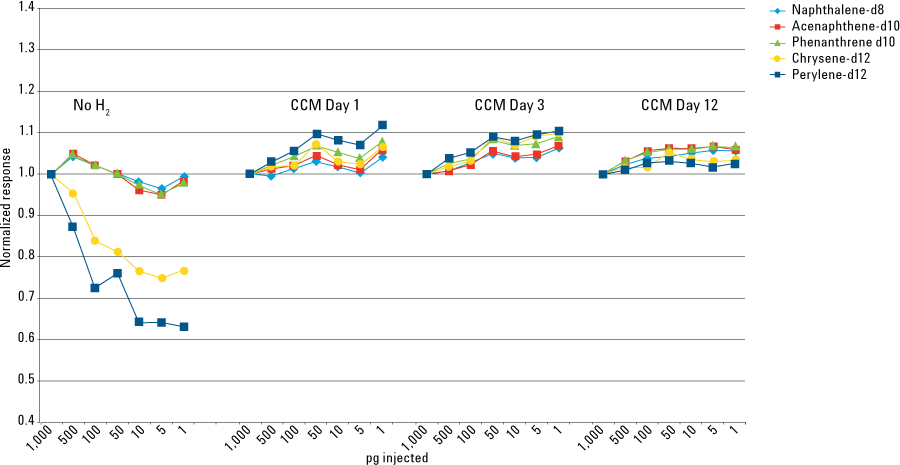Access Agilent eNewsletter, November 2013
>> Update My Profile | Subscribe to Access Agilent | Article Directory
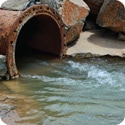
Enhanced PAH Analyzer: Optimizing PAH analysis using Agilent’s Self-Cleaning Ion Source
By Craig Marvin
Agilent GPD Solutions Business Manager
Toxic to aquatic life and a suspected human carcinogen, Polycyclic Aromatic Hydrocarbons (PAH) are monitored by researchers as trace contaminants in foods – such a shellfish and seafood – and as environmental contaminants in air, water and soil. PAHs originate from three source categories:
- Petrogenic – Derived from petroleum inputs associated with fossil fuels
- Pyrogenic – Derived from combustion sources
- Biogenic – Formed from natural biological processes
Technological advances have expanded laboratory capabilities beyond the HPLC/UV and GC/FID analysis of the 16 EPA priority PAHs to today’s trace level analysis of these compounds by GC/MS and GC/MS/MS. These latest advances have also allowed federal and state programs to expand their target lists and lower their reporting limits for PAH contaminants.
Analyzing PAHs offers a number of challenges
PAHs span a range of wide molecular weight and boiling point (BP) ranges, so a number of challenges can arise regarding their analysis. First, PAHs readily adhere to surfaces due to their sticky nature even though they are not considered active or subject to degradation. Second, their higher boiling points make PAHs subject to desublimation (deposition) and difficult to vaporize. Third, the peak tailing often seen with the late eluting PAHs frequently requires manual peak integration. For these reasons, some labs have struggled to meet new method requirements and have reported issues with linearity of calibration curves and variation with internal standard (ISTD) response across the calibration range.
 Enlarge
Enlarge
Figure 1. Reduction of MS background with hydrogen cleaning (left) and restoration of detector response following hydrogen cleaning (OFN response depicted, right).
Self-Cleaning Ion Source enhances MS performance
The Agilent Self-Cleaning Ion Source introduces small amounts of hydrogen directly into the source through a specially engineered auxiliary pneumatic control module (Aux EPC). Adding hydrogen to the mass spectrometer – with the filament current/electron gun on – creates active hydrogen species that clean the surfaces of the source, the detector, and other components. Hydrogen can be added during analysis for continuous cleaning, or can be added post-run to restore source performance. Figure 1 shows the improvement in background noise following a post-run cleaning with hydrogen, and demonstrates recovery of OFN response following hydrogen source cleaning.
How the Agilent Self-Cleaning Ion Source optimizes PAH analysis
Demonstrating optimization of the analysis required a re-evaluation of the complete analytical solution including inlet liner, inlet temperature, injection mode, inlet purge, analytical column, flow conditions, and detector settings. To meet sensitivity requirements we used splitless injection with a straight bore 4.0 mm liner with glass wool. Inlet temperature was set to 310-330 °C to vaporize the heavier PAHs. We employed a pressure pulse of 50 psi held for the full splitless time of 0.5-1.0 min to transfer the PAHs rapidly onto the column. We also developed a new analytical column, the Agilent J&W DB-EUPAH column (30 m x 0.25 mm, 0.25 µm), which allows 1-2 µL injections while better maintaining peak shapes when compared to other columns that were previously used for this analysis.
 Enlarge
Enlarge
Figure 2. S/N comparison of the target ion for dibenzo(a,l)pyrene (500 fg on-column) with (upper trace) and without (lower trace) hydrogen additions using the Self-Cleaning Ion Source.
 Enlarge
Enlarge
Figure 3. GC/MS PAH ISTD response for different calibration levels (normalized) using Self-Cleaning Ion Source with 9 mm Drawout lens. Calibration Range: 0.5-500 pg to MSD with Single Ion Monitoring (SIM).
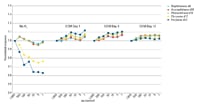 Enlarge
Enlarge
Figure 4. Consistency of ISTD responses as run by GC/MS/MS in the continuous cleaning mode (CCM). RSD >38% for analysis with standard configuration and RSD <8% for analysis with CCM operation of Self Cleaning Ion Source.
 Enlarge
Enlarge
Figure 5. Calibration curves for GC/MS/MS MRM Analysis dibenzo(a,l)pyrene (1-1000pg) using Self-Cleaning Ion Source with (left) and without (right) continuous hydrogen cleaning. R2=0.99998 for calibration with continuous hydrogen cleaning.
We performed the separation in the constant flow mode using backflush where the first column connected the inlet to the purged ultimate union (PUU) and a second, segmented column connects the PUU to the mass spectrometer (MSD).
To optimize the PAHs analysis, we configured the Self-Cleaning Ion Source with the Agilent 7890B/5977A GC/MS and 7890B/7000B GC/MS/MS systems. Depending on the MS configuration used, we introduced a low hydrogen flow, for example: 0.075-0.2 mL/min, continuously during data acquisition. Both the single quadrupole (MS) and tandem quadrupole (MS/MS) mass spectrometers were configured with a 9 mm lens. We set ion source temperatures to 320-350 °C and quadrupole temperatures to 180-100 °C for both detector configurations.
Figure 2 compares MSD signal-to-noise (S/N) of the target ion used for single ion monitoring (SIM) of the latest eluting PAH with and without the use of the Self-Cleaning Ion Source with 500 pg injected. The difference in height results from MSD tuning. Activation of hydrogen flow slightly increased noise resulting in a slight reduction of S/N. Despite the slight reduction, the S/N performance allows for the typical 1-1000 pg calibration.
To evaluate consistency of ISTD response, we analyzed a 7-level calibration standard of 30 PAHs with 5 ISTDs. Figure 3 depicts ISTD responses normalized to the response from the highest calibration level. With the addition of hydrogen through the Agilent Self-Cleaning Ion Source, ISTD responses fell within 5% RSD. Without the addition of hydrogen, ISTD responses dropped with decreasing standard concentration independent of the injection order for the standards. This drift in ISTD response makes accurate quantitation difficult and dependent on the amount of other analytes in the sample.
Figure 4 shows the consistency of ISTD responses as run by GC/MS/MS in the continuous cleaning mode (CCM). For the CCM study, we analyzed the same 7-level calibration standard with ISTDs used for the GC/MS tests using an Agilent 7890B/7000B GC/MS/MS configured with the Self-Cleaning Ion Source, a 9 mm extractor lens and 200 µL/min of hydrogen. CCM runs were repeated 3 and 12 days later to evaluate stability of system performance. The use of the Agilent Self-Cleaning Ion Source with continuous cleaning improved ISTD consistency from greater than 35% RSD to less than 8% RSD.
Both the GC/MS and GC/MS/MS configured with the Agilent Self-Cleaning Ion Source and optimized for PAH analysis demonstrated improved consistency in ISTD response, peak shape, and linear response for analyzed compounds. This optimization improved linearity of the calibration curve. Figure 5 compares a 7-level calibration curve for the latest eluting PAH analyzed by GC/MS/MS. Use of the Self-Cleaning Ion Source with continuous hydrogen cleaning improved linearity for the 7-point calibration curve of dibenzo(a,l)pyrene to R2=0.99998. Correlation coefficients for calibration curves ranged from R2=0.9997-1.0000 for all PAHS analyzed by GC/MS/MS with CCM operation.
The new Agilent Enhanced GC/MS and GC/MS/MS PAH Analyzers exceed the performance that most laboratories require for PAH analysis. When optimized for performance, both systems demonstrate improved consistency of ISTD response, reduced peak tailing, and sensitivity similar to and linearity improved over standard system configurations – especially when configured with the Agilent Self-Cleaning Ion Source. The use of the continual hydrogen cleaning helps maintain system performance without the need for the venting and downtime associated with manual source cleaning. Take a moment now to learn more about environmental contaminants in air, water and soil – and how the Agilent Self-Cleaning Ion Source can help to improve performance and increase productivity in your lab.
>> Update My Profile | Subscribe to Access Agilent | Article Directory
Figure 1.
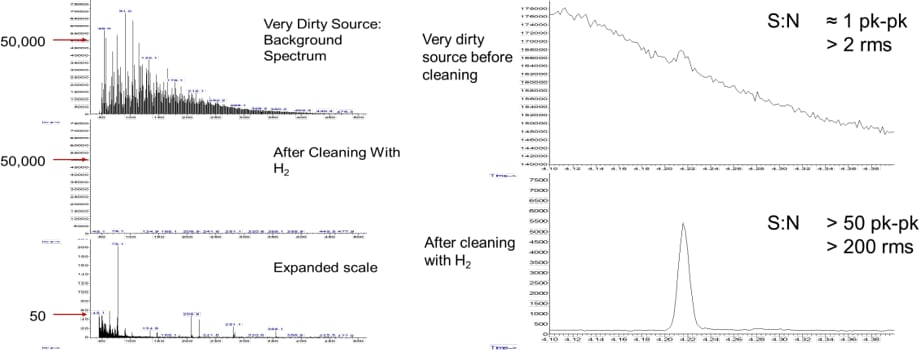
Reduction of MS background with hydrogen cleaning (left) and restoration of detector response following hydrogen cleaning (OFN response depicted, right).
Figure 2.
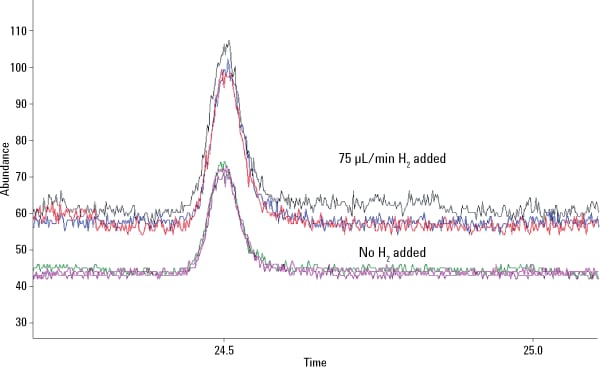
S/N comparison of the target ion for dibenzo(a,l)pyrene (500 fg on-column) with (upper trace) and without (lower trace) hydrogen additions using the Self-Cleaning Ion Source.
Figure 3.
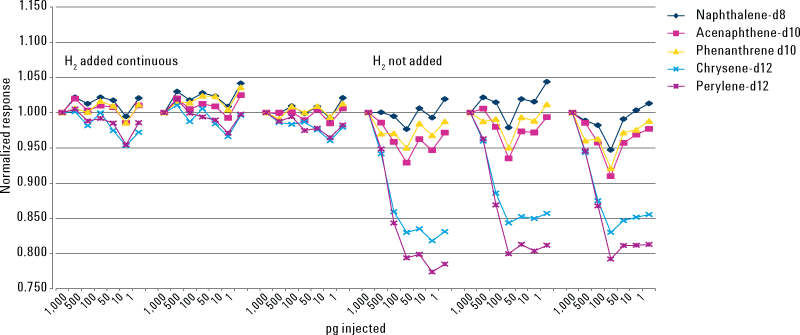
GC/MS PAH ISTD response for different calibration levels (normalized) using Self-Cleaning Ion Source with 9 mm Drawout lens. Calibration Range: 0.5-500 pg to MSD with Single Ion Monitoring (SIM).
